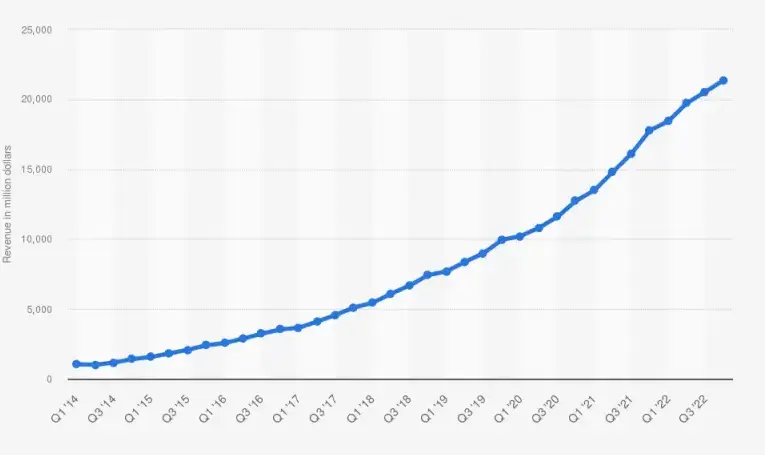Spiralling Cloud Costs
The Great aaS Segmentation: Exponential Service Costs & Feature Slicing

A New Frontier
The ideals were obvious:
- Defer upfront costs over time with the pay as you go model for specific services
- Reduce operating costs by benefitting from economies of scale with shared resources
- Avoid unnecessary costs by defining exact compute and storage requirements
- Remove overhead costs associated with hardware, building, and staff responsibilities
- Amortise growth costs by expanding globally with a network of distributed data centres
Only pay for what you need, when you need it.
Thriving Adoption & The Calm before the Storm
Amazon Web Services (AWS)
Even at the beginning of Amazon Web Services (AWS), there was demand for the platform, with in excess of 100 applications built within the service's first 2 years.
After the initial foundations were laid and the systems deployed for Elastic Compute Cloud (EC2) and Simple Storage Service (S3) in the 2000s, the growth that followed in the 2010s was near exponential.

Microsoft Azure
Just in time for the turn of the decade, and probably as a means to bolster Microsoft's resilience to the Great Recession, Windows Azure was announced in October 2008.
With the key web service available through Microsoft's partnerships, start-up programme BizSpark, and other insiders, the other core to every cloud service, databases, was announced the following March - specifically relational SQL.
Less than a year after, and initially free, Microsoft Azure was commercially available.
To truly capture the market, Microsoft expanded Azure to 48 countries, for a total of 89 countries and 19 currencies, with Virtual Machines, VPNs, Web Sites, and a new SDK and toolset. The "Hybrid Cloud" Infrastructure, Platform, and Software stack was taking shape.

Google Cloud Platform (GCP)
Around the same time, Google introduced App Engine in April, 2008. The service offered dynamic web, persistent storage, provision scaling, load balancing, in-house authentication and email APIs, as well as a local development environment.
Following parallel to Microsoft's announcement, Google revealed their own Virtual Machines service, Google Compute Engine (GCE) on June 28, 2012.

AWS, Azure and GCP have all shared a similar trajectory, with a similar growth rate over the past decade. As of April 2023, the number of individual products and services that each platform offers stands at 509 for AWS, 169 for Azure, and 190 for GCP.
Collateral Damage & Financial Fallout
It was never apparent that COVID would disrupt the world to the extent that it did. The pandemic was the death knell for many companies, but for those that survived entered an era of heightened competition, cyber warfare, and geopolitical tensions, to name just a few challenges of the decade so far.
Given all of these external factors that have affected both enterprise and consumers, it has become a key focus in reviewing operational costs, and that is for many subscribed services.
The model is so inviting and convenient, it isn't until you're invested that the incremental increases with withdrawn warnings, redefined terms, fractured features, and awkward, near impossible cancellation processes start to arise.
Cloud Repatriation & On Premises
A global pandemic with mandatory lockdowns rendered cloud computing compulsory. With poor or zero business function as the alternative, adopting cloud or accelerating migration was the logical choice.
Whether for business resilience, evolution of operations, remote working, employee welfare, or sustainability, there were plenty of reasons.
One such case at the start of the pandemic, in March 2020, saw a 775% increase in users for Microsoft Teams in Italy.
For some, after surviving the initial blow, entertaining the idea of reversing the virtual relocation has seen many forecast huge potential savings. One company in particular, 37signals who head up Basecamp and HEY, expects to save $7M by investing in 8-14 MSP-hosted Dell servers at a cost of $600K amortised over 5 years for the hardware, and an overall annual expenditure of $840K once the hosting has been factored in.
This pails in comparison to the gargantuan AWS bill of $2.3M in one year alone, or $190K per month.
The operation features everything you'd expect from a cloud operation; a Relational Database Service (RDS) running MySQL, Elastic Compute Cloud (EC2) Instances and Elastic Load Balancer (ELB), OpenSearch Service and ElastiCache, Simple Server Storage (S3), and CloudWatch.
At the other end of the spectrum, SEO giant Ahrefs roughly calculated a whopping $400M in savings by operating on premises with 850 Dell Servers vs running in the cloud on Amazon Web Services.
For most SMEs looking to expand that operate with a similar infrastructure, opting for an on premises setup in-house or with externally-managed leased hardware may be the way forward.
If cloud providers are focused on optimising their customers' clouds yet firing staff in the tens of thousands, what future reliability does that suggest?
If you're looking to refresh your hardware, expand your operations, or migrate from the cloud, contact us today with your requirements and we'll find your solution.


